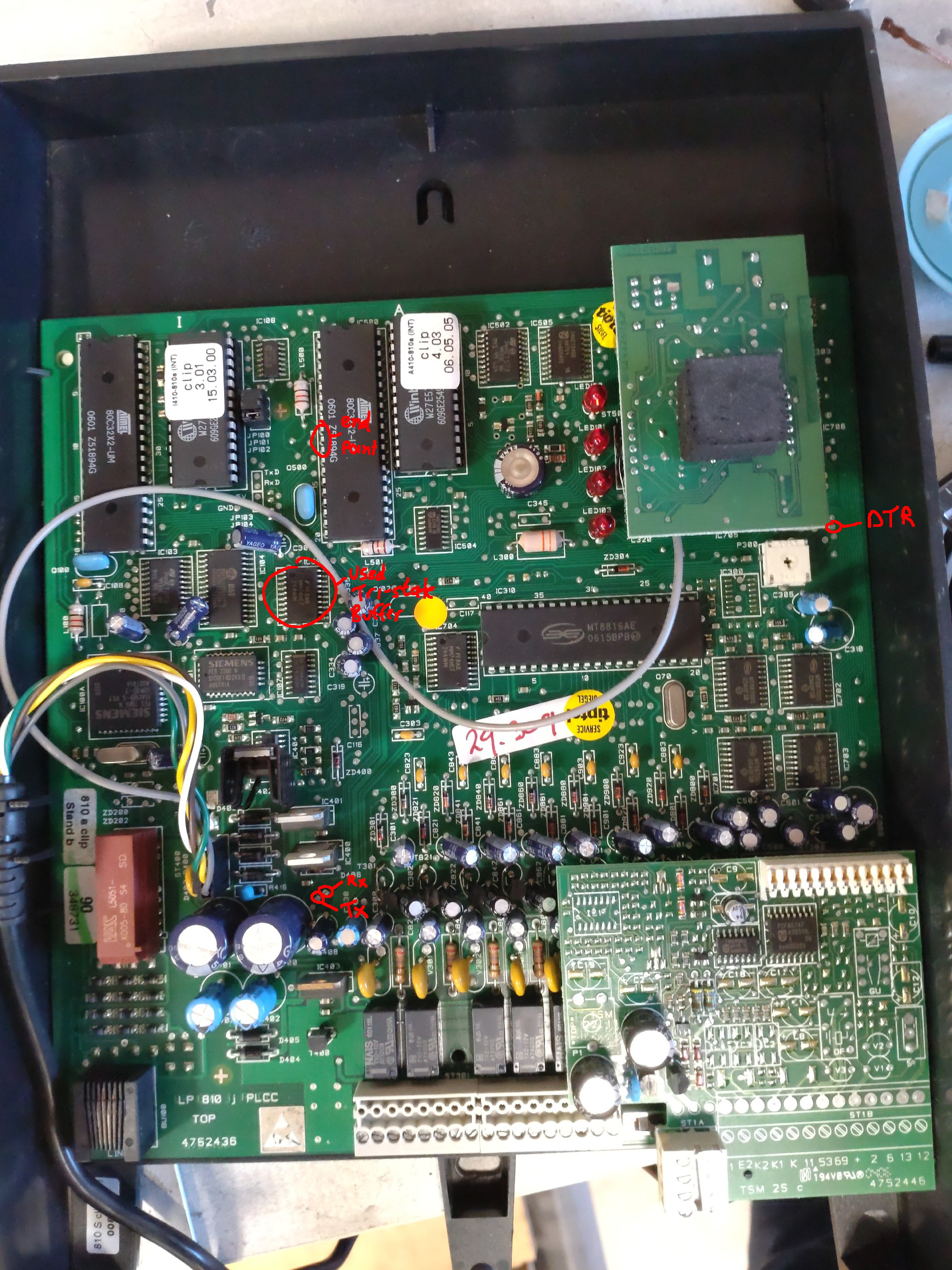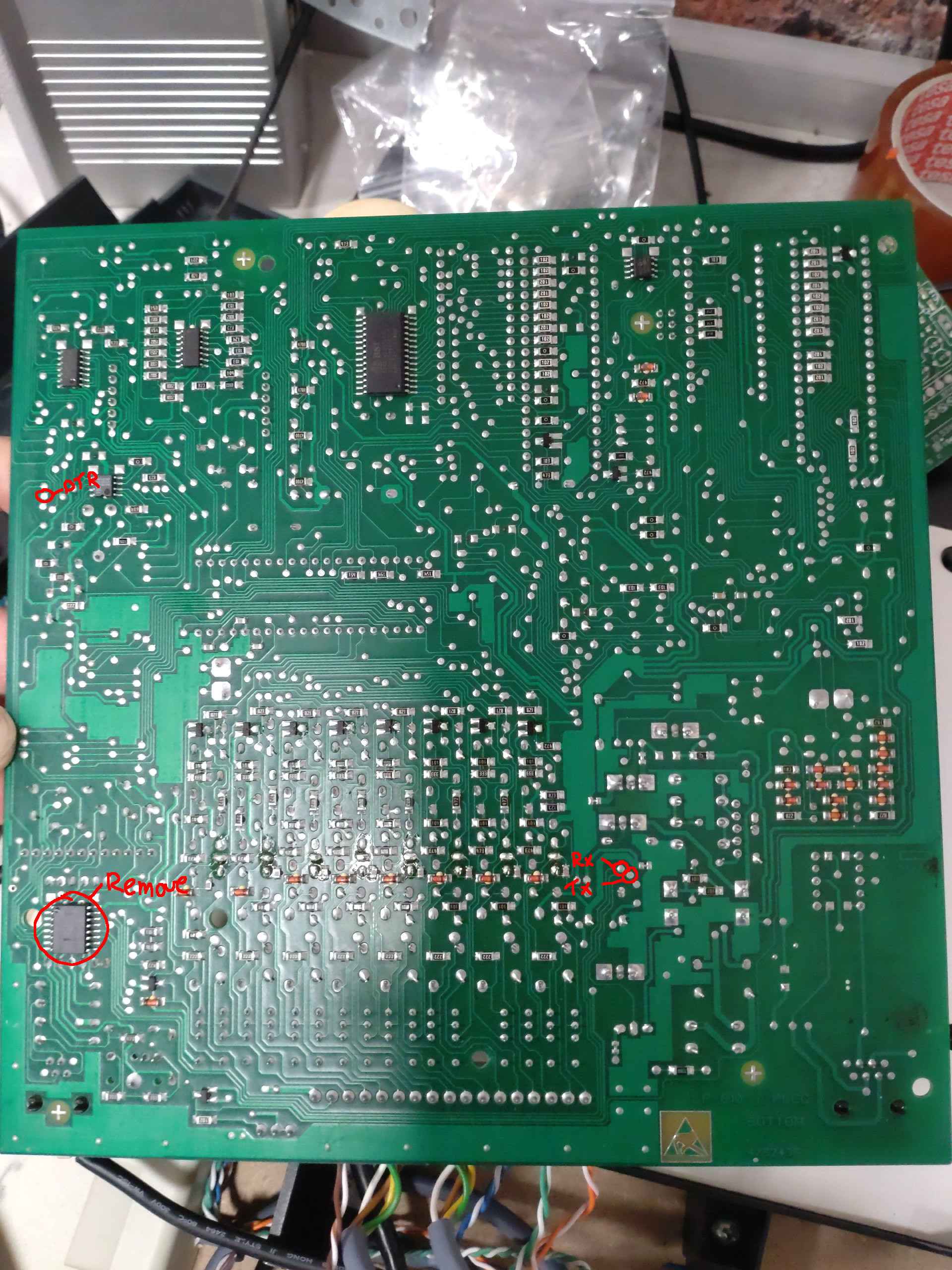Difference between revisions of "Tiptel"
(added decoded ascii, hey, it's the version!) |
(updates) |
||
| Line 37: | Line 37: | ||
=== serial === | === serial === | ||
| − | * It's RS232 (non-TTL, 12V) 9600,8,n,1; you | + | [[Image:tiptel_serial_front.jpg|thumb|points to connect TTL serial (front side)]] |
| − | * DTR is used as flow control | + | [[Image:tiptel_serial_back.jpg|thumb|points to connect TTL serial (back side)]] |
| + | * It's RS232 (non-TTL, 12V) 9600,8,n,1; you need a Max232 or genuine USB to RS232 adapter; tested with a PL2303 (note that Prolific USB drivers have not been reverse engineered on Wireshark) | ||
| + | * DTR is used as flow control (it's tied to the "extensions" (right hand side) microcontroller's interrupt0 pin via a HIN232 line driver/level shifter. | ||
* The 6P4C pinout is as followed (using female DB9): | * The 6P4C pinout is as followed (using female DB9): | ||
| Line 49: | Line 51: | ||
Tested ''tty_fake'', ''slsnif'' and ''interceptty'', but all corrupted the conection (probably due to DTR being used). | Tested ''tty_fake'', ''slsnif'' and ''interceptty'', but all corrupted the conection (probably due to DTR being used). | ||
| − | + | Experimented with wireshark USB sniffing (the serial data was not straightforward to decode): | |
* <code>modprobe usbmon</code> | * <code>modprobe usbmon</code> | ||
* <code>lsusb</code>: find the corresponding device bus and address | * <code>lsusb</code>: find the corresponding device bus and address | ||
* <code>sudo wireshark -k -i usbmon3 -Y "usb.bus_id == 33 && usb.device_address == 33 && usb.capdata"</code> | * <code>sudo wireshark -k -i usbmon3 -Y "usb.bus_id == 33 && usb.device_address == 33 && usb.capdata"</code> | ||
| + | |||
| + | Finally, wanting to use a logic analyser; I couldn't find it, tried with a makeshift Arduino as SUMP sniffer combined with Pulseview, but the buffer was way too short to do actual analysis on it. | ||
| + | Ordered an 8-channel super cheap FX2 analyser (fx2lafw), but it needed the firmware package: <code>sudo apt install sigrok-firmware-fx2lafw</code>. | ||
| + | |||
| + | Long story short: I used 4k7 resistors and 5v6 zeners, but still managed to short out the line driver and broke it. | ||
| + | I removed it, found some vias that had the TTL signals and connected a Serial adapter that has RTS implemented which seems to do the job. | ||
==== initial data ==== | ==== initial data ==== | ||
Latest revision as of 22:26, 2 February 2025
Contents
synopsis
Playing with PABXes..
Tiptel 810 S clip
This is an ISDN(2) PBX with 8 extensions (of which number 8 can be set as a door intercom).
Features:
- ISDN-2 connection (RJ45), connectable with a Fritzbox' S0 port
- screw terminals
- music on hold 3.5mm jack
- serial (RS232) 6P4C connector for programming
manual
The closest I could find to get something working on the PBX is Media:Tiptel_811_Manual.pdf, but not all numbers are correct (some need to be entered as single digit).
software
After a long search, xopr found configuration software 1.11 on archive.org. He wasn't able to connect using the Windows software under Wine+Mono, but the DOS version of this software works perfectly under DOSBox
steps
- Mount the CD:
mkdir ~/tiptel;fuseiso -p ./TIP_INST_V1.11.bin ~/tiptel/ - insert USB-serial adapter, verify its address (in this example
/dev/ttyUSB0 - edit
~/.dosbox/dosbox-0.74-3.conf, look for[serial]and setserial3=directserial realport:ttyUSB0- you can also add the mounts here in the autoexec part
- the "installer" doesn't work; just run it ad-hoc (the executable looks for the translation text file)
ISDN810.EXEENGLISH/TEXT.044
- run
dosbox, mount the directory:MOUNT D /home/xopr/tiptel/DOS_SOFT/(don't forget: Ctrl+F10 to release mouse) - execute (note that it won't be able to create
ISDN810.INIon the mounted "cd"):
D: cd ENGLISH ..\ISDN810.EXE
- select
COM3using the space bar and confirm with enter - Alt+s,n to set the MSNs (telephone numbers per extension)
- Alt+s,o to set either Telephone (allow call waiting) or modem, and check all
autom. accessfor direct ISDN access (press * switch to internal line) - upload changes: Alt+p,s
serial
- It's RS232 (non-TTL, 12V) 9600,8,n,1; you need a Max232 or genuine USB to RS232 adapter; tested with a PL2303 (note that Prolific USB drivers have not been reverse engineered on Wireshark)
- DTR is used as flow control (it's tied to the "extensions" (right hand side) microcontroller's interrupt0 pin via a HIN232 line driver/level shifter.
- The 6P4C pinout is as followed (using female DB9):
- DTR(4)+DCD(1)+RI(9)
- GND(5)
- TxD(3)
- RxD(2)
sniffing serial
Tested tty_fake, slsnif and interceptty, but all corrupted the conection (probably due to DTR being used).
Experimented with wireshark USB sniffing (the serial data was not straightforward to decode):
modprobe usbmonlsusb: find the corresponding device bus and addresssudo wireshark -k -i usbmon3 -Y "usb.bus_id == 33 && usb.device_address == 33 && usb.capdata"
Finally, wanting to use a logic analyser; I couldn't find it, tried with a makeshift Arduino as SUMP sniffer combined with Pulseview, but the buffer was way too short to do actual analysis on it.
Ordered an 8-channel super cheap FX2 analyser (fx2lafw), but it needed the firmware package: sudo apt install sigrok-firmware-fx2lafw.
Long story short: I used 4k7 resistors and 5v6 zeners, but still managed to short out the line driver and broke it. I removed it, found some vias that had the TTL signals and connected a Serial adapter that has RTS implemented which seems to do the job.
initial data
Connecting and enabling DTR gives:
a1 20 00 00 00 00 02 00 83 02 followed by a repeating 05
Connecting with DTR off gives:
a1 20 00 00 00 00 02 00 83 02 a1 20 00 00 00 00 02 00 80 02
Connecting and toggling DTR gives this each time:
a1 20 00 00 00 00 02 00 80 02 a1 20 00 00 00 00 02 00 83 02
and upon close:
a1 20 00 00 00 00 02 00 80 02 a1 20 00 00 00 00 02 00 00 02
Get version(s):
write:
06 03 80 13 93
read:
06 01
write:
06
read (ISDN? version):
15 81 14 00 21 05 20 33 30 31 31 35 30 33 32 30 30 30 02 01 00 a5 (····!· 30115032000····)
...
write:
06 02 a0 a0
read (Analog? version):
a1 00 04 07 20 34 30 33 30 36 30 35 32 30 30 35 b1 (···· 40306052005·)
Which results in:
Version (I): 3.01 15.03.2000 Version (A): 4.03 06.05.2005
Fritzbox connection
This documentation is a work in progress, but it is easy to accomplish.
- connect the ISDN port to S0
- set internet telephone number (or trunk/DID; shared password)
- add a PBX
todo
- tool and steps to export wireshark pcap to json, read and parse
- DTR toggle code
- actual data dissect
- Fritzbox steps

